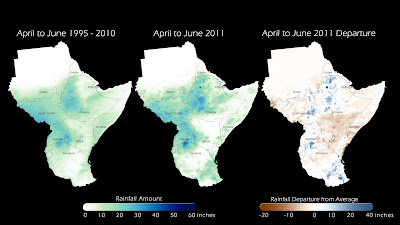 |
| Below average rainfall in the Horn of Africa has created a humanitarian crises. |
The Horn of Africa has experienced extended drought for the past decade. This year in particular, disappointing wet seasons in addition to the expected dry season have created a humanitarian crises. This NOAA page explains that the region is dependent on two rainy seasons: one in the fall and one and the spring. This past year has been especially dry, which creates a critical situation when considering the sub-Saharan summer. USAID has created a map that shows the most critically affected areas in terms of food security. This article from Plan details some of the hardships being endured by families in Kenya while this article in The Guardian discusses how the population of Djibouti is being affected. According to the latter article, up to 80% of livestock has been lost while food prices have risen 50% in Djibouti. USAID has taken action in the form of emergency assistance in the region. Although the people of the Horn of Africa are in dire need for aid now, this blog post from AlertNet makes the case for the importance of proactive measures. Risk reduction efforts ahead of time, Esther Williams writes, is incredibly cost efficient. With the projected influence of climate change, initiating adaptation in anticipation of future crises seems to be a better investment than waiting to react. This drought alone may kill up to 400,000 children due to starvation.

